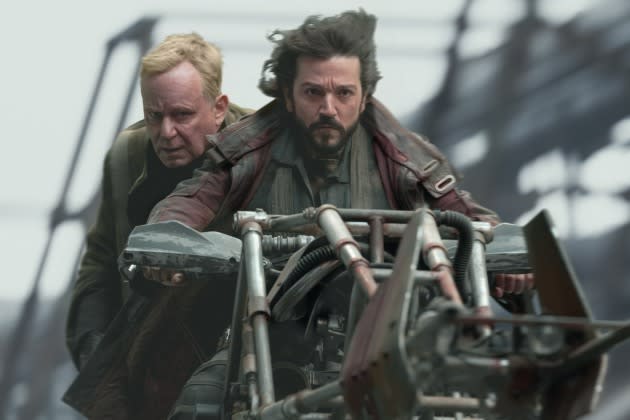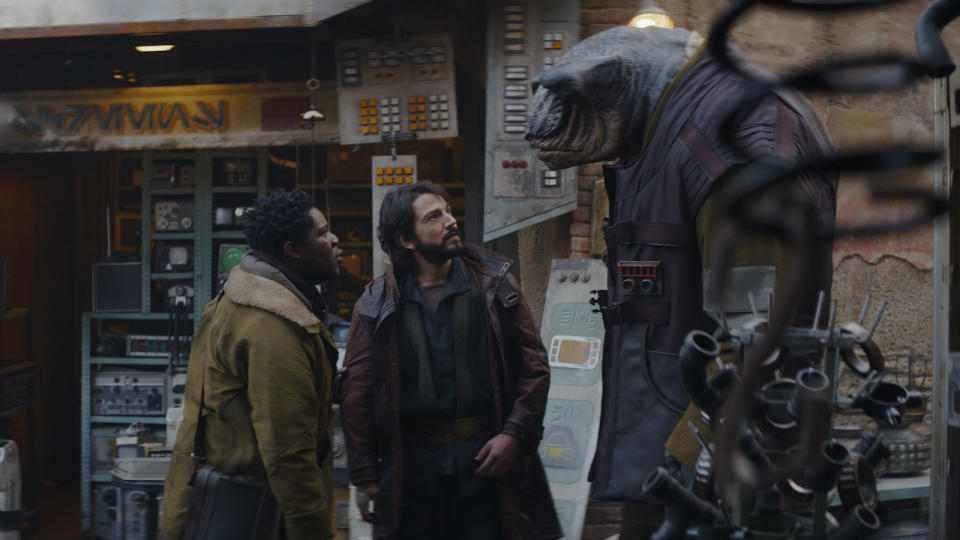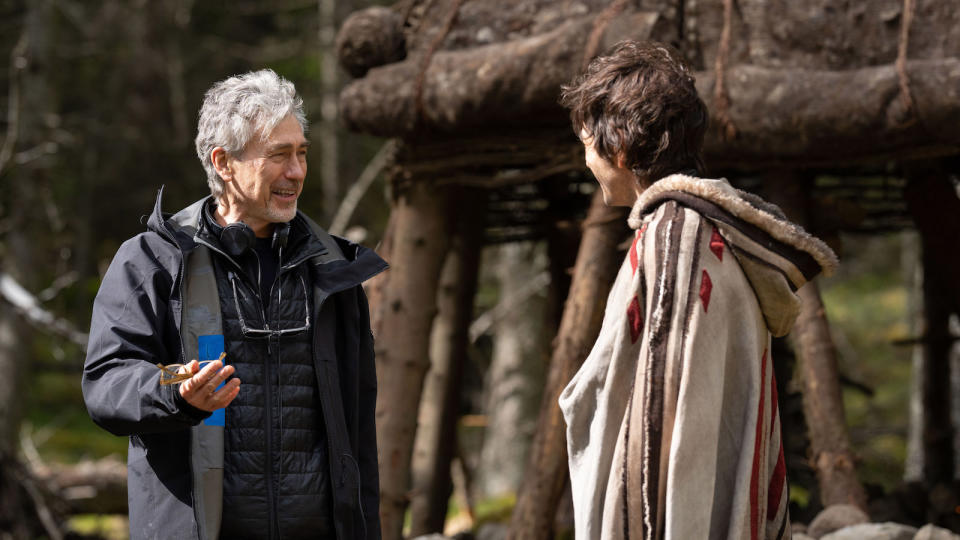How ‘Andor’ Became the First ‘Star Wars’ TV Series for Grown-Ups: ‘I Wanted to Do It About Real People’

Tony Gilroy didn’t want to make a prequel to “Rogue One.” The 2016 “Star Wars” feature, which Gilroy co-wrote, is itself a prequel, detailing how a ragged crew of rebels, led by spy Cassian Andor (Diego Luna), steal the plans to the Death Star. They succeed, but (spoiler alert!) they all sacrifice their lives doing so — an uncharacteristically dour ending for a “Star Wars” endeavor. The production was also infamously troubled, with Gilroy, who wrote four “Bourne” movies and wrote and directed “Michael Clayton,” stepping in to helm extensive reshoots in place of director Gareth Edwards. When the result was a massive hit, grossing just over $1 billion worldwide, Lucasfilm president Kathleen Kennedy was eager do more “Star Wars” movies with Gilroy.
“I remember Kathy saying, ‘What can we do?’ And I said, ‘Well, what kind of stories do you want to do?’” Gilroy recalls. “And she goes, ‘We could do anything.’ So I said, ‘Could you do, like, “Inherit the Wind”?’”
More from Variety
Gilroy, in other words, had no interest in making another grand space saga and moved on. But by 2018, Lucasfilm began developing a TV series set before the events of “Rogue One,” following Cassian’s life with his trusty droid K-2SO (Alan Tudyk). Gilroy wasn’t involved, but the studio sent him the script. “It was in the vein of Cassian and K-2 are like Butch and Sundance, and they’re gonna storm the Citadel,” he says. The material was fine, he adds, “but very hard to sustain over a long haul.”
So while still professing no interest in the job, Gilroy wrote “a long forensic manifesto” back to Lucasfilm that not only outlined why he thought that approach wouldn’t work, but what he thought the studio should do instead. “It was such a crazy idea,” he says with a wide grin. “It was so radical, so out there.”
That idea was “Andor.” The 12-episode first season, which is set to debut on Disney+ on Sept. 21, is indeed unlike anything ever attempted before in the 45-year history of the “Star Wars” franchise. Rather than turn Cassian’s life, pre-“Rogue One,” into a rollicking space adventure, Gilroy — who wrote five episodes and serves as executive producer and showrunner — uses Cassian’s story to depict, in almost Dickensian detail, the intertwining lives of everyday people as they orbit around the formation of the Rebel Alliance. While legacy characters like Mon Mothma (Genevieve O’Reilly) and Saw Gerrera (Forest Whitaker) do appear, the vast majority of the ensemble’s more than 200 actors are playing brand new characters, often inhabiting worlds we’ve never seen before. Most crucially, rather than wayward Jedi or secret Skywalkers, “Andor” follows lowly factory workers and midlevel technocrats, seemingly unremarkable characters who’ve long hovered in the background but were never granted the spotlight until now.
“I wanted to do it about real people,” Gilroy says. “They’ve made all this IP about the royal family, in essence. It’s been great. But there’s a billion, billion, billion other beings in the galaxy. There’s plumbers and cosmeticians. Journalists! What are their lives like? The revolution is affecting them just as much as anybody else. Why not use the ‘Star Wars’ canon as a host organism for absolutely realistic, passionate, dramatic storytelling?” As for any other legacy characters who may pop up in Season 1, they are, Gilroy says, “never fan service.”
“It’s never cynical,” he continues. “It’s always meant to be there. It’s always protein; it’s never icing.”
It was precisely Gilroy’s ground-level approach that convinced Luna to return to play Cassian again (he also serves as an executive producer). “It’s the articulation of a rebellion,” the actor says. “It’s not about one character saving everyone. It’s about community.”
That broader perspective surprised Kyle Soller (“Poldark”), who plays Syril Karn, an officious deputy inspector who runs afoul of Cassian. “It was completely different from what I expected the ‘Star Wars’ scripts to look like,” he says. “I had to flip back and look at the title: No, this is ‘Star Wars.’ I just felt like, ‘Wow, this is incredibly grown up, gritty, messy.’” At one point, he adds, Syril comes home “and spends some time with his mother, which is so un-‘Star Wars’-y.”
Doing a “Star Wars” show on this scale, Gilroy says, was only possible thanks to “the economics of streaming,” which he wielded to his full advantage. Rather than film inside the “volume” — the bleeding-edge soundstage filled with LED screens that “The Mandalorian,” “The Book of Boba Fett” and “Obi-Wan Kenobi” have all utilized extensively — the series’ ambitious storytelling required shooting on real locations and sprawling, fully constructed sets in London.

“I imagined that I was either going to be on a green screen, or that I would have been in front of a virtual set,” says Adria Arjona (“Morbius”), who plays Cassian’s friend Bix, a mechanic on the planet Ferrix. “They created an entire city. Ferrix actually exists. I was there.”
When Denise Gough, who plays Imperial security agent Dedra Meero, first shot on the Ferrix set, she was similarly impressed. “There was what looked like a sushi bar, and I looked in one of the bowls and there were blue noodles,” she says. “In the next one, there was a skewer with some sort of strange animals on it. I thought, ‘Wow, nobody’s ever going to see this. This is all done for us.’”
Those sets include everything from palatial homes to high-class brothels to housing projects, all designed to help ground the storytelling in relatable human complexity — and appeal to viewers beyond the “Star Wars” faithful.
“You should be able to watch the show and not give a shit about ‘Star Wars’ ever, or [have ever] seen any ‘Star Wars,’” Gilroy says. “This show should work on its own.” In the same breath, however, he adds, “The hope, the dream, is that the really hardcore ‘Star Wars’ community will embrace the show in a new way — that they’ll be thrilled to have someone come in and completely uncynically get down molecularly in their world and treat it like a real thing.”
Lucasfilm’s first three “Star Wars” shows for Disney+ were deliberately designed as family viewing, with straightforward plots and kid-friendly characters — in keeping with just about every other “Star Wars” venture since George Lucas’ original 1977 film. “Andor,” however, approaches its story with a level of mature, emotional sophistication and narrative complexity that sets it apart.
“I don’t think it’s a show for 9-year-olds, probably,” Gilroy says. Which is not to say the series doesn’t embrace its “Star Wars” roots. “We are an adventure story,” he adds. “We are a thriller. And in a really abundant way, we’re creating a lot of IP. Some of it’s ground level: products and TV shows, all kinds of things. They’re all brand new.”
Doing so proved far more all-consuming than Gilroy had originally intended. “I thought, ‘I’ll build the first season, get it up and rolling, and then someone else can take it over and they can go do it,’” he says. “That wasn’t really feasible.” Capturing the granular circumstances of ordinary people in the “Star Wars” galaxy — from the cereal they eat to the jewelry they wear — meant every last detail had to be designed, approved and fabricated.
“There were many times along the way where it just was like, ‘Man, what have I done to my life?’” Gilroy says. “‘Why did I do this? This just can’t be worth it.’ That’s a hard conversation to have with yourself when you’re in it.”
Things got particularly dire when Gilroy realized he’d created an outwardly impossible dilemma for himself: “Andor” starts five years before the events of “Rogue One,” and Gilroy’s plan was always to end the series right before the events of the movie. But Season 1, which spans a year of Cassian’s life, took just about two years to make. Maintaining the show’s expansive scope for four more seasons felt overwhelming.
“You just couldn’t possibly physically make five years of the show,” Gilroy says with a groan. “I mean, Diego would be, like, 65. I’d be in a nursing home.” He grimaces. “We were panicked. We can’t sign on to this forever.”

Then Gilroy says he, Luna and executive producer Sanne Wohlenberg (“Chernobyl”) hit upon “an amazingly elegant solution” that took advantage of the structure they’d adopted for Season 1, in which a single story arc unfolds over three concurrent episodes written and directed by the same team. (It’s why Disney+ is premiering the first three episodes together.) In November, “Andor” starts production on a second, final season of 12 episodes, and each three-episode block will cover a discrete number of days in Cassian’s life in a single year.
“When we come back, it’s a year later, and it’s a Friday, Saturday and a Sunday. And then we go away for a year,” Gilroy says with palpable excitement. “And then we come back for, I think, eight days. And then we go away for a year. And we come back, and it’s four days.”
Adds Luna, “’Star Wars’ is growing in ways that it can allow itself to have different expressions. We’re not part of a saga that doesn’t end. Our end is clear. It’s as clear as an end can be.”
It will also mark the end of Gilroy’s time working in a galaxy far, far away. He’s turned from his earlier moments of despair to feeling “proud” of “this sort of bespoke, enormous thing that we’re trying to make” — and possibly revolutionizing how audiences think of “Star Wars” in the process.
As one character says on the show, “Everybody has their own rebellion.”
Angelique Jackson contributed to this report.
Best of Variety
The Best Pop Culture Halloween Costumes for 2022: From 'Top Gun' to 'Euphoria'
'The Sopranos' Gets the Funko Pop Treatment in New Collectibles Release
From 'The Sandman' to 'Blonde': Books Made Into Movies and TV Series That You Should Read
Sign up for Variety’s Newsletter. For the latest news, follow us on Facebook, Twitter, and Instagram.

 Yahoo News
Yahoo News 
